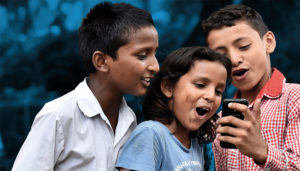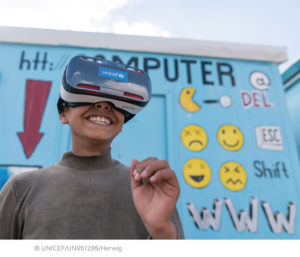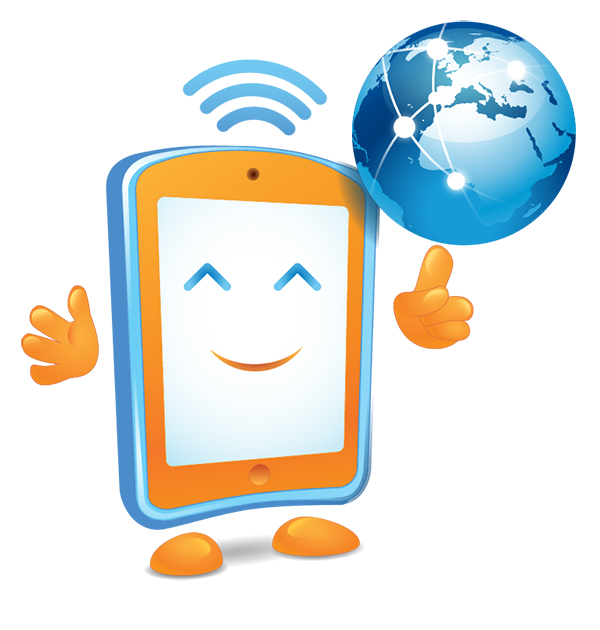For the past few years, Safe Internet Day has been celebrated around the world on 8 February every year. Its aim: to promote safe and positive use of technology, especially among children and young people. At the Observatory, we wanted to join the initiative by publishing an article on the urgent need to teach children how to make critical, safe and responsible use of new technologies that are increasingly changing their lives and conditioning their childhood.
Smart TVs that incorporate cameras, voice assistants that listen to you, mobile devices that geo-locate you, cookies that provide information on all our on-line activity and smart appliances that build a data mining network that tells absolutely everything about us: when we wash, when and what we eat, what we want and even what we might want.
It is technology. We love it and embrace it as something that has revolutionised humanity in recent years and made our lives much easier. Their opportunities have been and will be extraordinary. But we must not forget that, like almost everything else, it also has a dark and much less friendly side. And children are particularly vulnerable to its harmful effects.
AN URGENT NEED

© UNICEF/UN036675/Sharma
The Internet was born as a system for scientists around the world to share information. On 23 August 1991, the World Wide Web was launched to the world. In 1991, its users accounted for less than 1% of the world’s population. Today, 32 years later, there are 4,950 million people, that is, 62.5% of the world’s population. These are data from the report Digital 2022 by We Are Social and Hootsuite.
According to UNICEF, children and adolescents account for approximately one in three users. Increasing empirical evidence shows that children are accessing the Internet at younger and younger ages. In some countries, children under the age of 15 are as likely to use the Internet as adults over the age of 25. Smartphones are fuelling a “bedroom culture”, and, for many children, on-line access is becoming more personal, more private and less supervised (UNICEF, 2016). Digital technology has already changed the world and, as more and more children in every country go on-line, it is increasingly changing their childhood.
The UNICEF report analyses how digital technology affects children’s lives and concludes that, for the moment, technological development is ahead of us in terms of regulations and initiatives. At the moment, children are exposed to new risks and dangers, such as the misuse of their private information, access to harmful content and cyberbullying, while millions of underprivileged children have been left behind.
The widespread presence of mobile devices has made children’s online access less supervised and potentially more dangerous. At this point, what can we do to protect children from the risks of misusing these technologies? How can we train the new generations to make a critical, safe and responsible use of new technologies? What do you need to learn in order to become a “digitally competent” staff member?
IT’S NOT TECHNOLOGY, BUT EDUCATION
 Experts agree that the main problem is not technology, but the way in which the 21st century citizen is being educated. Young people must acquire digital skills and learn to use technology safely, ethically, critically and responsibly. Some studies have shown that while young children (digital natives) are fluent with new technologies, they lack the technical, critical and social skills needed to deal with the dangers they present.
Experts agree that the main problem is not technology, but the way in which the 21st century citizen is being educated. Young people must acquire digital skills and learn to use technology safely, ethically, critically and responsibly. Some studies have shown that while young children (digital natives) are fluent with new technologies, they lack the technical, critical and social skills needed to deal with the dangers they present.
In this sense, the teacher Marcela Momberg, an expert in the use of new technologies applied to education, defines digital skills as the skills that a citizen must have in this hyper-connected era in order to exist in the digital space. This includes skills to sift through information, to communicate, to take care of oneself, to create in a completely different space, to democratise information. It is a sum of skills that allow us to know what duties and rights we have in a space that is in continuous transformation. These skills must be generated from the classroom, with the accompaniment of parents and the support of institutions.
THE NEW DIGITAL TEACHERS
However, the incorporation of technology in education entails the challenge of training a new professional, a new teacher who is not only capable of integrating new technologies into their pedagogical skill, but who also knows how to guide their students in the critical, safe and responsible use of new technologies. Lucía Dellagnelo, president of the Centre for Innovation in Brazilian Education (CIEB), told us how new teachers must develop, among others, these skills linked to digital citizenship, as a guide to this digital citizenship for their students. According to this expert, numerous studies show that students expect guidance from their teachers on how to behave in cyberspace, in the cyber world. What the responsibilities and the implications of their digital presence are. The teacher has to be prepared to lead and promote the necessary discussions on these ethical and legal implications that the digital world brings today to all its users.
What does it mean to make critical use of new technologies and what should a teacher do to encourage and promote it?
The consumption of information has always been accompanied by the need to make use of critical thinking. Who tells us what? What are your credentials? Why should I trust this information? The great change that has occurred with the emergence of new technologies is that the volume of information we face today, on a daily basis, and the easy access of everyone to the production and consumption of this information, multiply by a thousand the need to make critical use of it. Today, it is more necessary than ever to learn how to assess the credibility of the information we consume. As content producers, we must also learn to produce relevant and appropriate content, using the right sources. How can we encourage this critical use of technology in the classroom?
- Promoting critical reading of digital content among students and analysing web content, publications and identifying reliable sources in class.
- Encouraging the conscious use of digital technologies, such as not sharing news without verifying the source.
- Preparing concrete activities that promote the critical reading of information, the understanding of its intention, its audience, its complexity and the impacts that this information can have on the life of the community.
- Conducting activities to enable students to search for, interpret and produce digital contents and resources in different environments.
- Involving students in the creation of spaces for dialogue and exchanges of experiences, ideas and opinions, encouraging them to adopt a critical attitude towards the roles and impacts that digital technologies have on the economy, politics and social life.
What does it mean to make safe use of new technologies and what should a teacher do to promote this safe use?
In the digital world, as in the analogue world, it is very important to know how to protect ourselves against possible risks: protecting our data and personal information and avoiding fraud, unsecured pages and receiving malicious information are some of the actions that we should internalise from a young age in order to make safe use of new technologies. How can teachers teach these habits in their classrooms?
- Presenting content on the risks to which they may be exposed, and proposing preventive safety measures and careful use of digital technologies so as not to compromise their physical health or their social or school life.
- Teaching the students strategies for the safe use of technologies, e.g. how to protect their data and how to create and activate passwords so that other people can’t use their personal devices and accounts.
- Reflecting on, and discussing with students, strategies for recognising the impacts that participation in digital culture has on their lives. You can also actively teach them to identify traps or situations of discomfort or risk and encourage them to create materials on the subject.
- Involving students, parents and teachers in activities on the safe use of digital technologies, promoting the development of methods and strategies for self-regulation in a proactive manner.
What does it mean to make responsible use of new technologies and what should a teacher do to encourage this?
Responsibility and respect for oneself and for others are vital attitudes and behaviours that help us to live together in society and make us good citizens and better people. These values must also be transferred to the 2.0 world. When we become “digital people” interacting on-line, we must behave with the same responsibility and respect for ourselves and others. Thus, girls and boys need to be taught how to live positively in the digital space. What can a teacher do about this?
- Propose thematic projects on the responsible use of digital technologies to the students.
- Teach the students concrete strategies for responsible use of digital technologies and encourage them to communicate ethically in the different digital environments.
- Encourage students to reflect on the subject, for example by involving them in debates on the social, economic and ethical implications of the use of new technologies.
- Incorporate the responsible use of digital technologies into routine activities with the students, promoting the creation and sharing of materials on the development of responsible digital citizenship.
- Encourage students to connect on-line with diverse environments and people, thus exercising conscious and ethical interaction and debate.
As we have seen, the need to educate critical and responsible digital citizens is urgent. More and more. Schools and teachers are in a unique position to promote the safe, critical and responsible use of new technologies. But it is no less true that, in order to develop their teaching work successfully, they need a clear framework to be provided by institutional policies and public administrations. We are facing a historic opportunity that governments, teachers, private institutions and civil society organisations must seize in order to develop content, educational resources and working methodologies in the classroom that will allow the next generations to live in the digital world in the best possible way.
REFERENCES
Dellagnelo, Lucia (2021). Interview ProFuturo Observatory. To be published.
INTEF (2016). Use of technologies by children up to 8 years old. A qualitative study in seven countries. Madrid. 2016.
Reig, D. and Vílchez, L.F. (2013). Young people in the age of hyperconnectivity: trends, keys and perspectives. Madrid. Telefónica Foundation and Encuentro Foundation. Madrid. 2013.
UNICEF (2016). 2017 State of the World’s Children. Children in a digital world. Paris. 2016.
We Are Social and Hootsuite (2022). Digital 2022.






